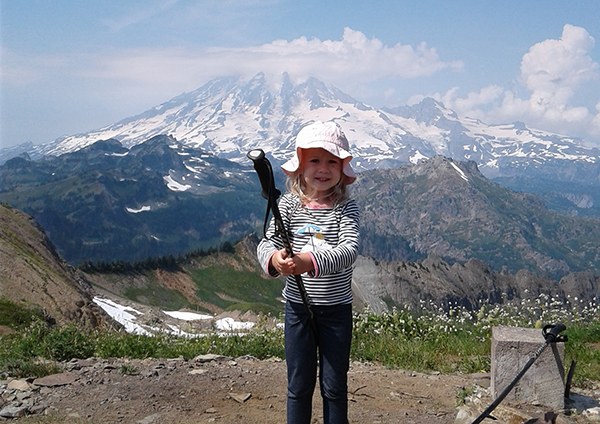
When most people think of Mount Rainier National Park, they think of the park’s namesake peak, a towering 14,441-foot stratovolcano that’s famous the world over. But Washington State’s iconic mountain only scratches the surfaces of the area’s summit possibilities. Longtime Mountaineers Gene Yore and Mickey Eisenberg identified the 100 peaks surrounding Rainier and set about climbing these lesser-known gems. Gene, who took on the challenge at age 72, overcame cardiac arrest and a broken femur on his way to reaching all 100 peaks.
Their journey inspired a book, Guide to 100 Peaks at Mount Rainier, which provides routes descriptions, tracks, and maps to the summits they reached. Most of the peaks are scrambles, a few are climbs, and 15 are hikes.
Each year, Gene and Mickey host an event to celebrate folks on their quest to complete all or part of the list. Medallions are awarded to those who check off various benchmarks. Some are climbers, some are scramblers, and some are hikers – all are welcome. That being said, the group had never welcomed a four-year-old into their ranks until Karl Themer and his daughter Vera came along. Here’s their story:
My love for Mount Rainier National Park began long before the birth of my daughter. For many years I explored the area, often seeking new climbing and hiking challenges. I scrambled up peaks, enjoyed climbs on Little Tahoma, and summited the “big one” – Rainier – by a variety of routes. About five years ago I discovered Guide to 100 Peaks at Mount Rainier by Gene Yore and Mickey Eisenberg. Their book stirred my imagination with new Rainier possibilities, many of which I’d never heard of before. I started ticking off more peaks in 2013 with an eye to one day finishing the whole list, or at least half of it.
The next year my wife Mia and I welcomed our daughter Vera into the world, and suddenly the pursuit of larger outdoor adventures was on hold. Mia and I both enjoy exploring the wild places of Washington and beyond – a passion we wanted share with our daughter. But with a newborn we had to be more selective with our outdoor trips, so I started looking for activities we could safely enjoy together.
I was looking at the 100 Peaks book one day when I realized that not only were 15 of those summits attained by hiking trails, many of them were reasonably close to a trailhead. That summer I convinced my wife that I could bring Vera to those summits with me. I had a new project and a great reason to buy new outdoor gear, namely a child carrier (or two).
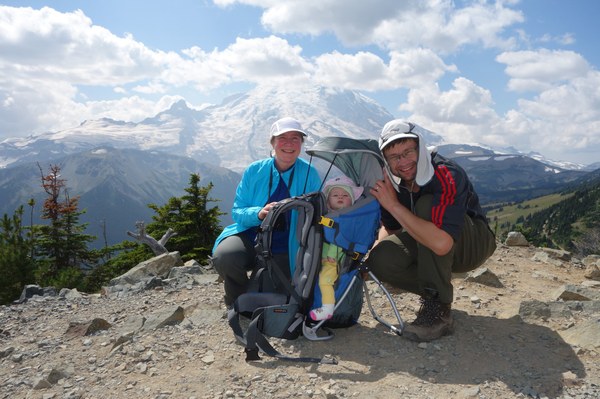 Karl, his wife Mia, and their daughter Vera pose in front of Mount Rainier.
Karl, his wife Mia, and their daughter Vera pose in front of Mount Rainier.
The first summer we attempted only the shortest hikes, all of them starting at the park’s Sunrise area. We also limited our adventures to fair-weather conditions. Hiking with an infant requires a certain amount of preparation and precaution. I used a carrier, which can be worn on the chest or the back with a head cover. I always wore a jacket that was large enough to close around the bundle with the zipper shut to keep out the wind when it picked up. And of course, we had to carry diaper supplies and extra hats and clothes. Vera would often sleep while I walked at a steady rhythm, and we quickly learned to keep an eye out for fallen booties and gloves.
We saw grouse en route to Brown Peak and watched a hungry ground squirrel on the way to Mount Fremont; we strolled through Grand Park and picnicked below Skyscraper Mountain; we ran the ridge between Antler and Dege Peaks. By the end of the year, we had five summits under our belt.
The next summer Vera was one and a half. She could sit up in a backpack carrier and enjoy longer outings. She could also hike some of the distance herself, often multiple short segments ranging from a quarter to half a mile. A lot of patience is required when walking with a little one; we made frequent stops to examine rocks, sticks, pinecones, holes in the ground, and anything else at eye-level for a toddler. This was also the summer we took her on her first backpacking trip. Aurora Peak is too far from the trailhead to do in one day with a child, so we pushed a jogging stroller up the Westside Road for four miles before hiking to a camp on the Puyallup River. The next day she waded in St. Andrews Lake before continuing to the top of Aurora Peak. We spent another night by the swollen river before hiking out. Vera enjoyed the tenting experience and has since hiked to many more lakes for an overnight stay. We enjoyed expansive views from Crystal Peak, visited the lookouts on Shriner Peak and Gobblers Knob, trudged up Bearhead Mountain with friends, and passed throngs of tourists before tagging all three tops of Burroughs Mountain. We reached another eight of the hiking summits that year, bringing our total to 13.
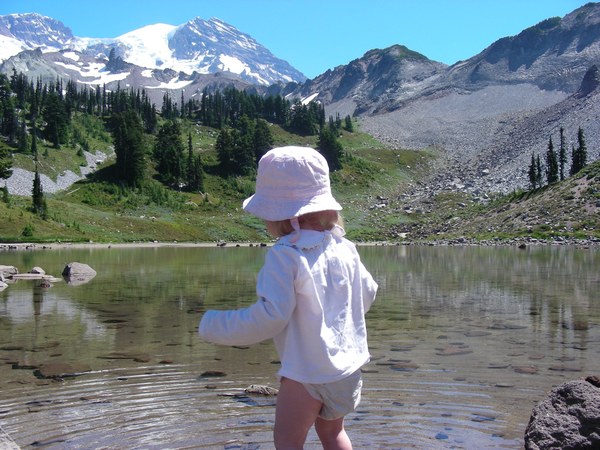 Vera wades into St. Andrews Lake.
Vera wades into St. Andrews Lake.
Our plans changed the following year because we were out of the country for much of the summer. We still hiked frequently with Vera, but we were stuck at 13 summits – two hikes short of completing the hiking summit list. It wasn’t until a year later, in 2017, that we attempted the last two hikes, Norse Peak and Tatoosh Peak. I realized then that I had made a mistake in leaving the two longest day-hikes (ten miles for Norse, twelve for Tatoosh) as the last to complete. Vera was over 30 pounds at this point and I also had to carry enough food, water, and clothing for both of us. Fortunately, she could hike a few miles on her own as a three-and-a-half year-old, but for most of the distance she was on my back.
A child that age can be very entertaining, often singing (the same song repeatedly) or jumping and dancing in the pack. She was also very inquisitive, asking where the birds live, what the squirrels eat, why the animals were hiding, why the butterflies are different colors, why the trees are so tall, where the water comes from, and so on. When she did walk she was creative: one of her favorite games was converting one of my hiking poles into a witch’s broom.
Tatoosh Peak proved particularly challenging. On our first attempt it was cold and raining; on our second the heat was oppressive and the bugs plentiful. We turned around each time, not wanting to assume such risk with the weather. Finally, in mid-August the conditions were right for a third and ultimately successful attempt. Vera ate lunch and played on the summit and seemed mildly aware of what we had accomplished. As luck would have it, my boot fell apart on the descent and I hiked the last five miles without a sole under my right foot. It was well worth the effort however; the project was complete, and a shiny new medallion was waiting for us the following spring from Gene and Mickey.
Hiking with my daughter to these summits was a wonderful experience for all of us. My wife joined us on about half of the trips, and now Vera asks us to take her camping and hiking each year. We did well to seize the opportunity when we did; Vera is too heavy for me to carry over many miles now. Instead we find destinations she can reach herself, typically one to two miles from the trailhead. Small alpine lakes with good camping make perfect weekend outings. We don’t have a new project to work on (yet) but the desire to keep exploring continues to bring us outside.
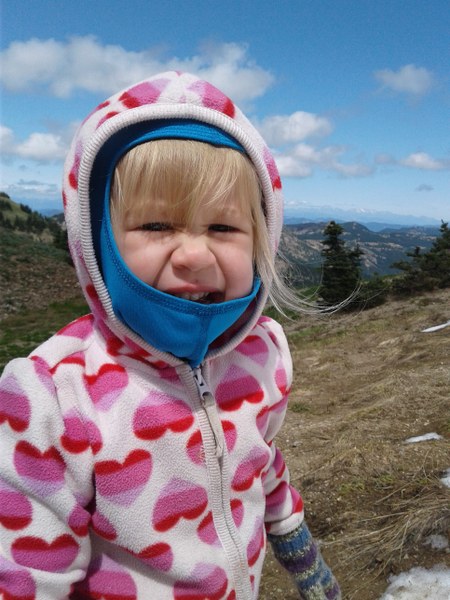 Vera during the descent from Norse Peak.
Vera during the descent from Norse Peak.
Tips for Hiking with Little Ones
We learned some good tricks to succeed at hiking with a small child. Above all the little one must remain warm and well-fed.
FOOD
A hungry tot will complain and stop on the trail. Bringing a variety of snacks can extend the time that a kid has sufficient energy and desire to play and move on the trail. We soon realized not to plan for a single lunch break, rather many small snack breaks that help keep the adventure moving.
CLOTHES
Multiple layers and extra clothing helps avoid problems with sudden wind or cold. One should assume that a sock or glove will disappear; small children often won’t mention that they have lost an item until it is far behind. Frequent checks of their hands and feet can prevent gear from becoming lost. Puddles and snow patches often become playgrounds, offering another reason to keep extra clothes on hand.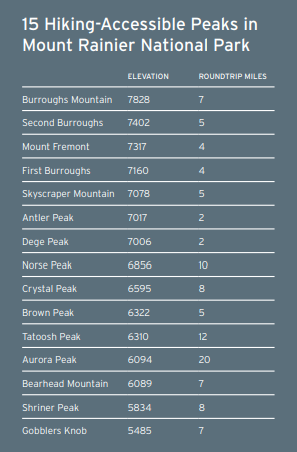
Guide to 100 Peaks at Mount Rainier National Park is available on iTunes and as an electronic book (for tablets and phones). It is also available as an iBook through the Apple bookstore. All royalties are donated to The Mountaineers. If you're a Mountaineers member, visit our benefits page for a free online version. To learn more about joining the peaks of Mount Rainier National Park challenge, visit our Seattle Branch Award Badges page.
Interested in getting outside with your little one? Check out our new Mini Mountaineers program, designed for kids ages 2-5 and their accompanying adults.
This article originally appeared in our Spring 2019 issue of Mountaineer Magazine. To view the original article in magazine form and read more stories from our publication, click here.
Add a comment
Log in to add comments.hello karl i found your old geocities website from your trip in europe 1999-2000
 Karl Themer
Karl Themer